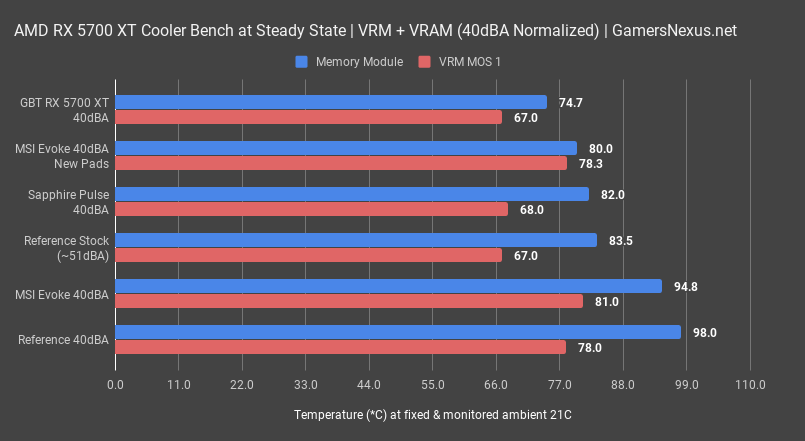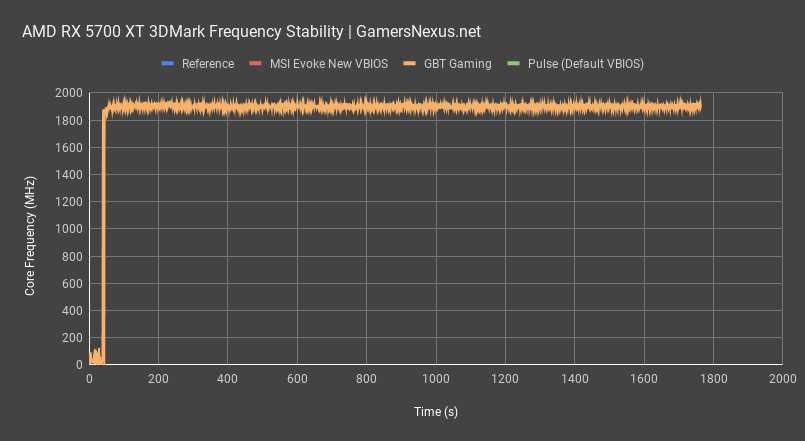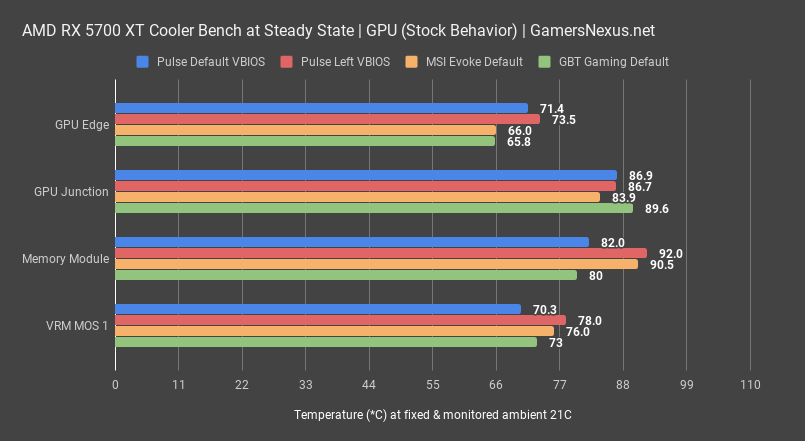Gigabyte RX 5700 XT Gaming OC Review: Thermals, Noise, & Value vs. Pulse & Evoke
Posted on
We’ve already reviewed the reference RX 5700 XT, the Sapphire Pulse model that we received as a frontrunner for board partners, and the MSI Evoke OC, which was overall poor value when compared to cheaper solutions on the market. Now, we’re looking at the Gigabyte Gaming OC card, the first triple-axial fan contender in our RX 5700 series benchmarks. It all comes down to thermals and noise with these, as gaming performance is functionally the same between each card when stock, and so we’ll focus-down on if Gigabyte can achieve competitive thermals at equivalent noise to the Sapphire and MSI cards. At $420 MSRP, the Gigabyte Gaming OC is priced around the Pulse and just below the Evoke.
For this testing, we’re focusing most heavily on thermals and noise. As a reminder, and we’ll say this in the conclusion as well, board partner cards ultimately come down to thermal and acoustic differences. There are a few that have extreme impact on XOC capabilities, like a KINGPIN or HOF card, but none of the 5700 XTs that we’ve yet looked at focus on that market. Gaming benchmarks become unimportant, as performance remains unchanged in nearly all partner designs. The one exception is the Evoke OC, which posted roughly a +2% performance advantage over baseline reference/Pulse performance, but otherwise, expect no meaningful or even measurable performance impact in gaming from these cards. The biggest gain is in massive quality of life improvements, such as reduced noise levels (in a noticeable way), reduced thermals, features like extra VBIOS on-board (the Pulse has this), or fitment advantages.
Test Methodology
We have overhauled the host test bench and had updated with new games. Our games selection is a careful one: Time is finite, and having analyzed our previous testing methodologies, we identified shortcomings where we were ultimately wasting time by testing too many games that didn’t provide meaningfully different data from our other tested titles. In order to better optimize our time available and test “smarter” (rather than “more,” which was one of our previous goals), we have selected games based upon the following criteria:
- Game Engine: Most games run on the same group of popular engines. By choosing one game from each major engine (e.g. Unreal Engine), we can ensure that we are representing a wide sweep of games that just use the built-in engine-level optimizations
- API: We have chosen a select group of DirectX 11 and DirectX 12 API integrations, as these are the most prevalent at this time. We will include more Vulkan API testing as more games ship with Vulkan
- Popularity: Is it something people actually play?
- Longevity: Regardless of popularity, how long can we reasonably expect that a game will go without updates? Updating games can hurt comparative data from past tests, which impacts our ability to cross-compare new data and old, as old data may no longer be comparable post-patch
Game graphics settings are defined in their respective charts.
We are also testing most games at all three popular resolutions – at least, we are for the high-end. This includes 4K, 1440p, and 1080p, which allows us to determine GPU scalability across multiple monitor types. More importantly, this allows us to start pinpointing the reason for performance uplift, rather than just saying there is performance uplift. If we know that performance boosts harder at 4K than 1080p, we might be able to call this indicative of a ROPs advantage, for instance. Understanding why performance behaves the way it does is critical for future expansion of our own knowledge, and thus prepares our content for smarter analysis in the future.
For the test bench proper, we are now using the following components:
GPU Test Bench (Sponsored by Corsair)
Component | Courtesy of | |
CPU | GamersNexus | |
GPU | This is what we’re testing! | Often the company that makes the card, but sometimes us (see article) |
Motherboard | ASUS | |
RAM | Corsair | |
PSU | Corsair | |
Cooler | NZXT | |
SSD | Plextor 256-M7VC | GamersNexus |
All memory timings are completely controlled for our new GPU testing, which has significantly tightened our error margins. Windows is version 1903. Note that some games, like GTA V and Hitman 2, have been manually tuned outside of a simple preset to ensure we have a proper benchmark. GTA V uses 2x MSAA in our testing, as it runs into engine frame limits at 187.5FPS and triggers engine-level bugs. Hitman 2 has crowd simulation and sound simulation settings that we tune back to the 4-core setting, as running higher than that creates a CPU bottleneck (and more of a CPU benchmark, as a result).
40dBA Noise-Normalized Thermals (GPU Temperature) – RX 5700 XT
Noise-normalized thermals are up first. We use these tests to configure all coolers to a noise level of approximately 40dBA when measured at 20” and in a room with a noise floor of 26dB. This allows us to normalize for fan speed and eliminate the ability of a cooler to jump to the top of the charts simply by way of having faster fans. At this noise level, the Gigabyte RX 5700 XT ends up with the lowest edge temperature by far, but a junction temperature roughly tied with the Sapphire Pulse at equivalent noise levels. This opens up an interesting discussion: As Edge temperature is no longer used as a boosting gauge, it becomes significantly less relevant as compared to Junction temperature, which is used for determining GPU boosting behavior and power throttling. Further, because Edge temperature is a sensor at the literal edge of the die, it’s possible that slight cooler differences could have a bigger impact on this result without meaningfully impacting the Junction temperature. Junction measures the hottest of all the sensors on the die – Radeon VII had 64 – and reports that, so we get a clearer picture of weak points.
With regard to the metric that matters, then, Gigabyte’s Gaming OC falls right in-line with the Sapphire Pulse – they’re within error for Junction – and not distant from our modified MSI Evoke with increased mounting pressure. As for unmodified cards, Sapphire and Gigabyte are neck-and-neck here, with the Gigabyte card holding an advantage for edge temperature. That said, given how much variance we’ve seen in edge temperature just by remounting a cooler, we’re not convinced this metric is meaningful. Junction is what we care about.
40dBA Noise-Normalized Thermals (VRAM/VRM Temperature) – RX 5700 XT
Thermals for GDDR6 on the boards positioned the Gigabyte at the top of the results, with GDDR6 measuring at 74.7 degrees Celsius while noise-normalized to 40dBA. This puts Gigabyte about 5 degrees lower than the next closest, which is MSI’s Evoke after we modified the cooler with area-appropriate thermal pads and more mounting pressure. The next stock card is the Sapphire Pulse at 82 degrees Celsius, still well within reasonable operating temperature, and then the significantly louder AMD reference design at 51dBA. MSI’s unmodified Evoke lands at the bottom of this list, resultant of thermal pads approximately 40% of the total necessary size and also poor mounting pressure, thus poor overall cooler-to-pad contact, and limited pad-to-module contact.
GDDR and VRM components only need to be within reasonable operating range, ultimately; it’s not like GPU temperatures, where lower temperature will give more boosting headroom, and GDDR6 memory overclocking is more limited by Navi than by thermals. Gigabyte gets points for a technical victory here, we just want to emphasize that it’s in territory where the gains aren’t necessarily meaningful beyond what’s already achievable on the modified Evoke or the unmodified Pulse. VRM thermals aren’t perfectly comparable as card-to-card MOSFET differences eliminate our ability to draw linear comparisons, but we still get to see that the Gigabyte card’s VRM thermals are well below the rated temperatures that often permit 115 degrees Celsius to 150 degrees Celsius.
In our upcoming tear-down of the Gigabyte card, you’ll see that memory temperatures are advantaged as a result of direct airflow coming down and hitting the memory coldplate. The memory isn’t buried beneath plates and heatsinks, and so air can actually get down to it.
Frequency Response on RX 5700 XT Models
Plotting frequency with full stock settings, no changes, and running 3DMark Firestrike Extreme, the Gigabyte card ends up running at about 1885-1930MHz, with an average frequency closer to 1915MHz. The total range isn’t that different from Sapphire’s Pulse with the default VBIOS, just a bit more stable in terms of amplitude. MSI’s Evoke has a higher sustained clock – attributable to its 2% gaming uplift on average, though this could be achieved with a light OC on any card – and demonstrates a relatively flat frequency in this chart.
Frequency-RPM Response & Auto Fan Speeds
This chart shows the fan speed versus GPU temperature for the Gigabyte card, allowing us to better understand how the fan curve works. While the card maintains roughly a 69-degree Celsius Edge temperature, the fan typically rests at around 1700RPM. We see some occasional spikes up toward its maximum fan speed, which is over 4000RPM, but these are rare. What we’re unsure of is how accurate those spiked readings are – we may use our RPM gun on this if it becomes suspicious, but for now, the average fan speed is below the 2000RPM we use for 40dBA normalized testing, and so you could bring fan speed up on the card while remaining reasonably quiet.
Memory & VRM Thermals with Auto Settings
Running at stock settings, without any manipulation of the default fan speed curve, we exit direct noise-level comparisons but allow for an out-of-box use case analysis. The Gigabyte RX 5700 XT runs a GPU Edge temperature target of about 66 degrees Celsius, the same as the MSI Evoke OC when left stock. This is the target to which fans will adjust, as shown in our previous fan speed chart. The Gigabyte card’s Junction temperature ends up higher than the 40dBA test, as fan speeds are lower with the card fully stock, so it’s plotting about 90 degrees here. That puts Gigabyte as warmer than the Pulse and MSI cards when left to manage its own fan speeds. As for memory and VRM temperatures, Gigabyte maintains the strongest GDDR6 memory temperature performance of the pack, almost entirely thanks to the direct airflow, and VRM thermals are also acceptable.
Conclusion
Before getting deeper into the concluding thoughts, a quick reminder on gaming: As we illustrated in our RX 5700 XT Pulse review, and talked about in our Evoke review, gaming performance is of minimal concern from one card to the next. If you’ve already decided you want an RX 5700 XT, the real question that needs to be asked is how the thermal and acoustic performance is for each card, and perhaps how the fitment allows or disallows your case of choice. We did actually run the gaming tests (3 resolutions x 5 games), but all results came out equal. No point wasting charts on it – it’s all the same as the Pulse, and given that frequency is identical, that makes sense. The Evoke OC maintains a rough 2% lead in gaming performance, but faces other deficits in thermal performance and value proposition.
As for overclocking, for non-XOC cards, that’s also mostly of no consequence. These cards are all going to be more limited by the silicon than by the PCB, although partial limitations may emerge as a result of cooler design. In this instance, testing overclocking capabilities would be tantamount to playing the lottery – it’s on the GPU, not on Sapphire or Gigabyte to grab more OC headroom with Navi GPUs. If you start pushing chilled cooling or LN2, sure, the VRM will matter, but silicon quality is paramount to overclocking performance, and so it is largely inconsequential to the review.
Ultimately, then, we see the Gigabyte RX 5700 XT Gaming OC as better value than the MSI RX 5700 XT Evoke OC video card, we see the Gaming OC as competitive-to-slightly-better in thermals versus the Pulse (depending on metric), and there’s nothing special with the PCB. The card lacks the dual BIOS that the Pulse has, which we do think is a massive advantage that Sapphire holds over its competitors, but the rest is mostly tied. Of what we’ve tested thus far, you’re choosing between the Pulse and Gaming OC, and that choice will be dictated by these items:
- Availability
- Price
- Size
Availability is the governor of all RX 5700-series purchases right now, it seems, so that’s our first limit. Price is next – if they’re the same, pick whatever you think fits your use case better (for literal size/fitment or for style) or grab the Pulse for the extra VBIOS; if one card is cheaper than the other, buy that one, barring desire for extra VBIOS on-board. Finally, for size, the Pulse is taller, and so may not fit in some smaller form factor cases. The Gaming OC is longer but standard height, posing restrictions in cases that are more horizontally-challenged.
Gigabyte has done well for thermal performance on the GDDR6 memory modules, and we commend them for that. The rest is largely fine – not spectacular, but not spectacularly bad, either. We’d like to see a second VBIOS to compete more directly with the Pulse, but otherwise, the Gaming OC is among the two 5700 XT series cards that we can presently recommend.
Editorial, Testing: Steve Burke
Video: Josh Svoboda, Andrew Coleman






